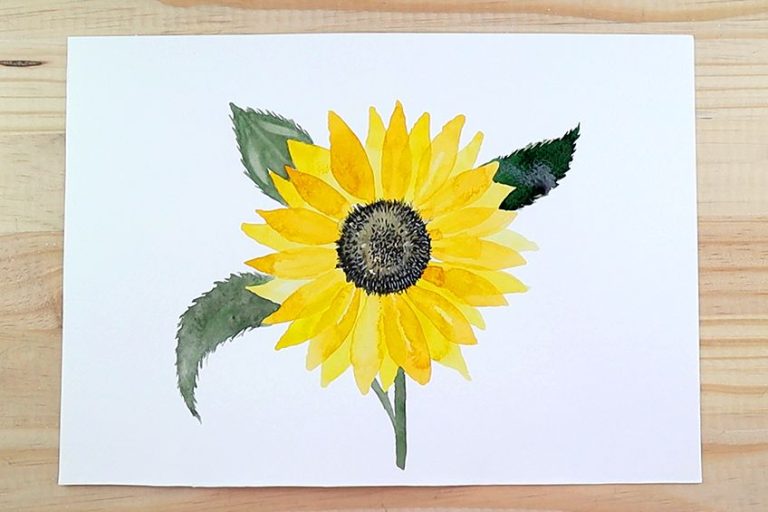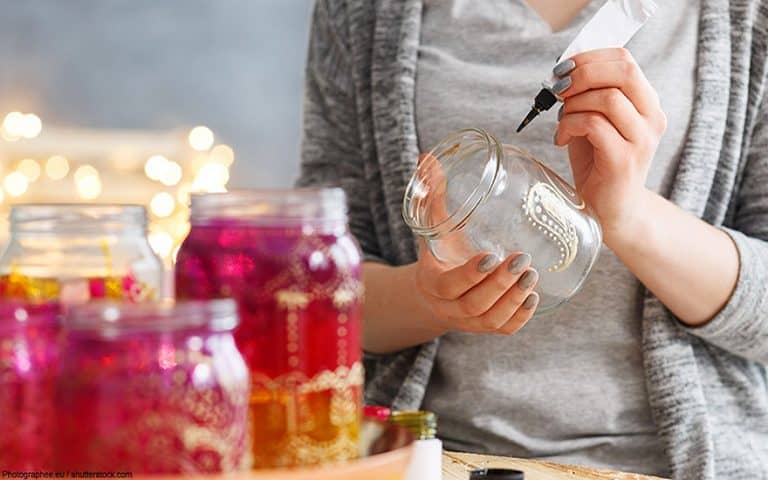Best Paint Pens for Wood – Your Easy Guide for How to Write on Wood
This post may contain affiliate links. We may earn a small commission from purchases made through them, at no additional cost to you.
Projects where you write and draw on wood have been quite trendy for a few years now. From décor in houses and restaurants to signs at events, you’re bound to have seen drawings or writing on wood at some point. Are you wondering how to write on wood? Well, this article is all about drawing with paint markers for wood. We cover what you should look for in a paint marker for wood, how to care for your markers, and what are some of the best pens for writing on wood.
Table of Contents
- 1 What Is a Paint Marker for Wood?
- 2 What Should You Consider Before Purchasing Paint Pens and Markers for Wood?
- 3 What Are the Best Pens for Writing on Wood?
- 4 Tips and Tricks for Using Paint Markers Correctly
- 5 How to Write on Wood Using Paint Pens: A Step-by-Step Tutorial
- 6 Ideas for Projects Using Paint Markers on Wood
- 7 Frequently Asked Questions
What Is a Paint Marker for Wood?
A paint pen/marker for wood is exactly what it sounds like, it has a paint-like consistency rather than a runnier, ink-like flow rate. Paint markers that work on wood would have more vivid colors than most markers and will likely work on other surfaces such as rocks, glass, ceramic, canvas, or fabric. This means that they are a versatile investment for creatives. You can purchase paint markers for wood that are either water or oil-based. Water-based paint pens will be thinner and more absorbent than oil-based paint pens. They will also usually be less opaque. Oil-based paint pens on the other hand will be less likely to fade or wear away with ease. This is because they are thicker. Keep in mind, however, that oil-based paint pens for wood can be harder to work with and store correctly.
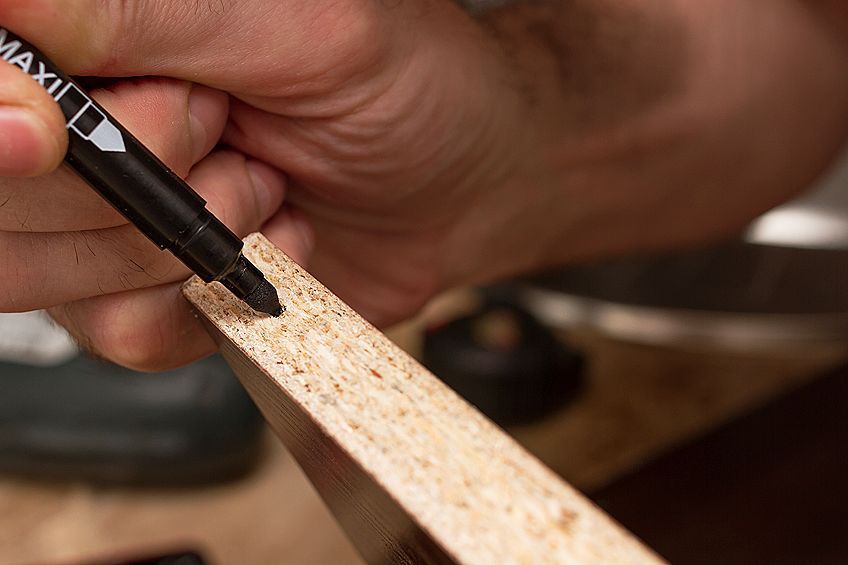
We discuss the benefits of using either type of paint pen for wood in-depth later in the article. It is important to use paint markers that work on wood specifically. Any regular paint marker has a higher chance of bleeding outwards when applied to wood. This can stain the grain haphazardly and make your piece appear untidy or dirty. It is definitely worth the extra money to invest in quality, specialized paint markers for wood.
When Would You Use Paint Markers for Wood?
Paint markers for wood are extremely versatile. You don’t only need to use them for your projects on wood. In fact, most paint pens should be suitable for a variety of other surfaces such as rocks, ceramic, canvas, brick, and more. Paint pens are great for children too, just make sure that you have bought the non-toxic variety.
The pens are suitable for novice crafters and professionals because of how easy they are to handle and care for compared to traditional acrylic and oil paints.
Why Do You Need a Special Paint Marker for Wood?
Wood naturally has grains on its surface. This means that it can be a tricky medium to work with. The roughness makes it unsuitable for pencils and crayons since you couldn’t easily fill in-between the grains. The pigment application would look messy and half complete if you had to try. The best way to use wood as a drawing medium is to paint it, but some people struggle to use paintbrushes on wood. This could be because of inexperience or simply because they find that fibers of a paintbrush are less precise on such a rough surface. If you try to paint something with precision or intricacy on the surface of the wood while using a paintbrush, you may find that small imperfection will appear as you work.
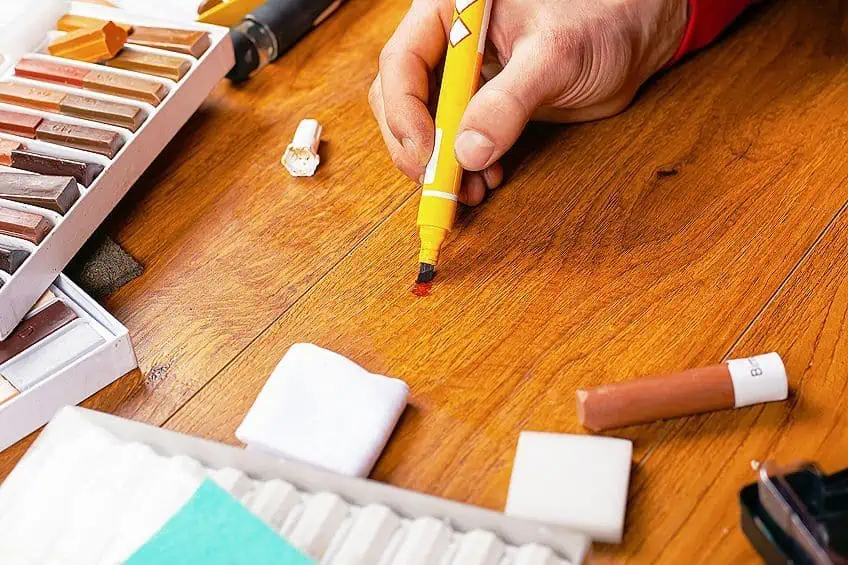
You could fix this by painting over the errors. This means layering up the paint on the surface of the wood until the area is smoother and neater. Painting over errors isn’t always an option; if you’re going for fine calligraphy, you will not want to paint over errors and thicken up your lines in this way. Using layers of paint to achieve a smoother surface will also use unnecessary amounts of paint that could otherwise be saved. This is why using a paint pen to write on wood is such a great idea. Paint markers for wood offer you the control of a pen with the vibrancy and smooth application of paint. They are perfect for intricate work such as calligraphy but can also be used for bigger drawings. If you are using a paint marker for wood, you will probably find that it works on other mediums too.
This means that paint markers for wood are very versatile art supplies to have in your collection.
Paint markers save much more space than regular paints and are very easy to store. They come in many colors or can have tips of different shapes and sizes. Paint markers for wood have environmentally friendly and non-toxic variations. Most paint markers for wood will be made with vibrant pigments and thicker binders which mean that they are high-quality pens that can be used for many other projects
Overall, using a paint pen to write on wood has many advantages that other drawing mediums simply do not provide in one place. They are often made specially to work on wood without breaking the bank or making a big mess. Once you decide to use paint markers on wood, you will still need to decide what factors are most important for your purposes and decide what type of paint marker you will be using.
What Should You Consider Before Purchasing Paint Pens and Markers for Wood?
There is a wide range of different paint pens for wood available on the market. Each one can differ in tip size or shape, paint type, drying time, quality, price, or toxicity. Below we discuss each of these characteristics in-depth and talk about what it means for you when trying to decide which marker is best. Remember that the usefulness of each marker characteristic will depend on what you are planning to use it for. Think about what you plan on making when using a paint pen to write on wood. Consider what this means about the conditions it will be exposed to or what purpose it will serve.

Paint Type
The main difference to take note of when selecting your paint pens for wood is the type of paint being used. The type of paint you use influences how well the paint will flow, the ease of use and storage, the drying time, the durability, and more. There are two types of paint pens to choose between.
We have outlined the two in more detail below.
Water-Based Paint Pens for Wood
Water-based pens are easier to work with since they readily come out of the pen. They likely won’t require much shaking beforehand or during use, and they have a thinner consistency which means they are less likely to clog or clump. Their thin constitution means that you may be able to shade and mix colors more readily than with oil-based markers. They will flow more smoothly and dry slower than their oil-based counterparts, however, they may be more prone to bleed out into more porous woods than oil-based paint pens would be. Overall water-based paint markers for wood are mostly problem-free. They are usually low odor and easy to clean up. If they land on a stray surface they can be removed with a damp cloth or mild detergent.
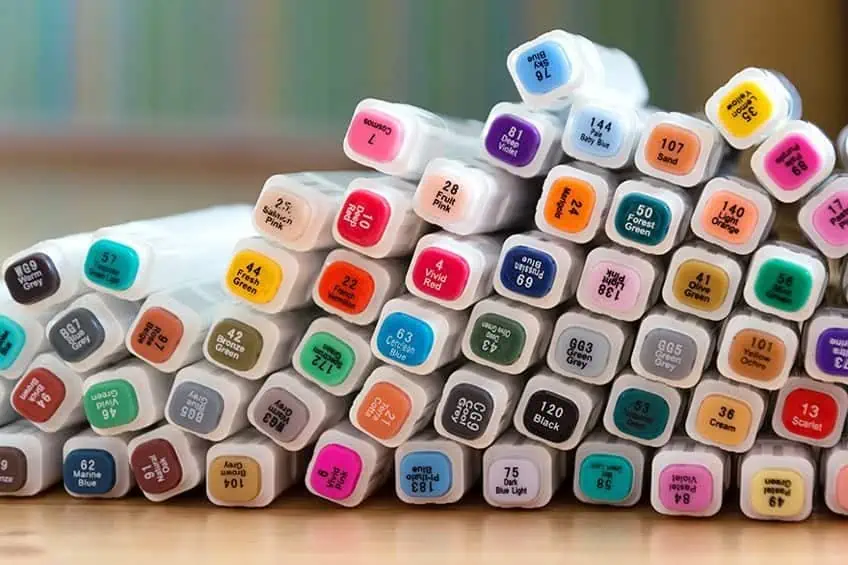
If already dried they can generally be scratched off fairly easily. The only downside to this is that water-based paint pens can be less durable and vibrant than oil-based paint pens. This issue can be somewhat remedied by investing in higher-quality water-based paints. There are many vibrant and durable water-based paints on the market that can readily compete with oil-based markers in this regard. Alternatively, you could opt to seal your piece with varnish once complete. The varnish can improve the vibrancy of the paint and add a protective layer to the wood. If it isn’t quite the look you are going for or you do not want to take the risk with pricier water-based paint pens then you might opt to use oil-based paint pens instead.
Oil-Based Paint Pens for Wood
If you are hoping for a paint pen that is more durable and opaque, then you would be better off using oil-based paint pens on your wood. Oil paints are trickier to use and can often be considered a bit unforgiving. You will usually need to shake the marker before you begin using it, and may need to shake it intermittently while drawing. Some brands will be better in this regard when compared to others. You may not even need to shake them at all.
Oil-based paints are more easily preserved than water-based paints and often dry to be more vibrant than their water-based counterparts.
They may have a stronger odor that can prove unappealing to children or people with sensitivities to scent. Make sure to try to use them in a well-ventilated room or work outdoors. Alternatively, you could buy an odor-free brand and avoid the worry altogether. Oil-based paint pens are more prone to drying up or clumping if stored incorrectly. Make sure that they are stored correctly but follow the manufacturer’s instructions or read some of the tips and tricks we mention later on in the article.
| Water-Based Paint Markers | Oil-Based Paint Markers | |
| Consistency | Thinner | Thicker |
| Opacity | Less opaque | More opaque |
| Vibrancy | Often less vibrant | Often more vibrant |
| Durability | Less durable; may be easily wiped off, smudged, and removed | More durable; can be difficult to remove without damaging the wood’s surface |
| Drying Time | Dries more slowly | Dries quickly |
| Odor | Usually mild to non-existent | Can be strong and unpleasant |
| Flow Rate | Smooth; not prone to clumping and clogging | Smooth but may be prone to clumping and clogging |
| Ease of Use and Storage | Fairly easy to use and store correctly, requires less priming and shaking | More tricky to use and store correctly, may require more frequent priming and shaking |
Different Tips on Paint Pens for Wood
The tip of your paint pen is another important thing you will need to consider. The shape and size of your tip, as well as the material it is made from, will affect how well it performs on your chosen wooden surface. Below we have summarized everything you need to understand when choosing what marker tip is best for your needs.

Tip Shape
The shape of the tip on your paint pen marker can determine how readily it applies to your wood or how finely you can create detail. If you are not planning to create intricate lettering or patterns then you would be better off with a shape that is better suited for maximum area coverage. The three main shapes you will encounter on markers are bullet tips, chisel tips, and brush tips. Bullet tip markers are rounded and full. They are used to draw thick lines on surfaces and are good for both writing and coloring. Bullet tips are the most versatile of tip shapes, and it is this quality that makes them the most commonly used. They are readily available due to their popularity and work especially well on wooden surfaces.
Chisel tip markers have an edge that is slanted like a chisel, as the name suggests. This slanted edge means that a marker with this tip shape can draw thick and thin lines, depending on the angle that is used. Chisel-tipped markers are great for lettering and calligraphy. You may have noticed a chisel tip is often found on highlighters because of their ability to draw thick, crisp lines across a page with ease. Chisel-tipped markers are versatile and suitable for many purposes, but they can struggle to create rounder lines.
Brush tip markers have a tip that resembles that of a paintbrush. The thickness of each stroke is easily determined by the pressure applied. The tips of the brush are good for creating detail but these tip shapes are more likely to result in paint bleeding on the surface of the wood. They can also be tricky for people that do not have experience using paintbrushes. Using a brush-tipped marker for wood defeats the purpose of using a marker in the first place. Remember that the coarse texture of the wood can cause the brush fibers to create lines and jagged edges without warning. We suggest using other tip shapes when using paint markers for wood.
| Bullet Tip | Chisel Tip | Brush Tip | |
| Shape | Full and rounded | Slanted and angular | Soft and flexible |
| Line Thickness | Thick | Thick or thin, dependent on the angle | Thick or thin, dependent on the pressure applied |
| Main Application | Versatile, for drawing, calligraphy, etc. | Best for lettering and calligraphy | Versatile, for drawing, calligraphy, etc. |
| Flow Rate | Average | Average | High – can cause bleeding |
| Suitability on Wood | A great choice for wood | Good choice for wood | Bad choice for wood |
| Ease of use | Very easy to use | Easy to use | Can be tricky to use |
Tip Size
Fine point tips allow for great amounts of detail and precision. These tips are great if you are creating a very intricate or detailed piece. This tip is suitable for wood only in this instance, otherwise, it can prove too tiring to work with for larger works that require a lot of filling with color.
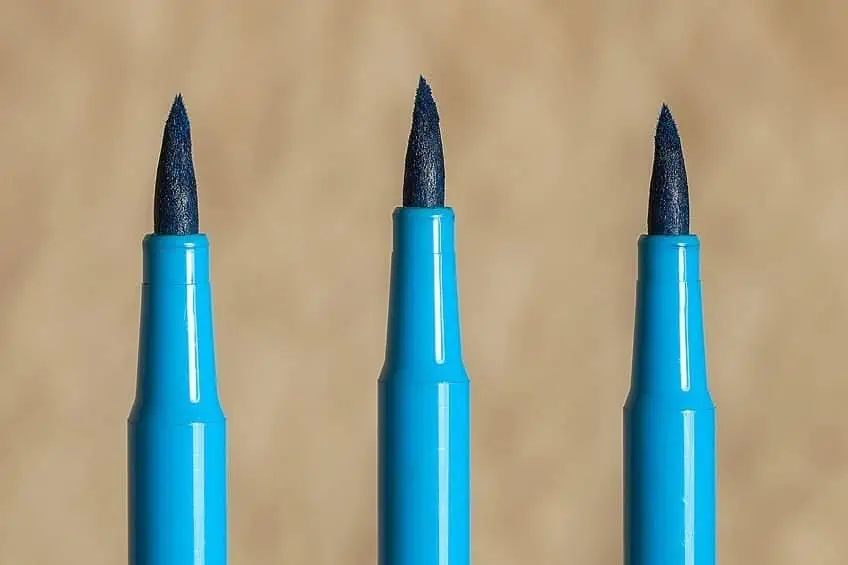
Alternatively, you may need a broader tip to create a large sign or to fill an area with color easily. In this case, you can opt for a medium-tipped paint pen. These paint pens are better for covering greater surfaces with ease and can be easier to control for some people. Their only downside is that they tend to have less color variety.
Tip Material
You will want the tip of your paint pen marker to be durable and resistant to damage since you are using it on wood. Wood is an abrasive surface and can easily damage your marker. Felt is one material used to make paint tips, but it may wear out easily on a rough surface like wood. Since they are made from plastic, they are firmer than nylon tips and might be even easier to control. However, since it is imperative that you don’t easily wear down the tips of your markers on wood, we still suggest using nylon tips unless you are working on a sanded down or smooth wood surface where abrasion may not be a very big issue.
Nylon is similar to a brush in terms of flexibility but is still firmer than you might expect. Nylon is less likely to wear down from abrasion against the wood.
Colors Included
Be sure to take a good look at the full range of colors and specialized pigments available to you when choosing paint pens for wood. These include primary and secondary colors as well as pastel and metallic colors. The color set you choose will depend on what you plan on making as well as how much experience you may have as a crafter. If you are just starting out, you will probably be more comfortable using a basic set of markers with six or so colors. However, if you are more advanced you might consider trying a bigger set with some metallic or pastel shades.

Whether you want a big or small set it is always a good idea to work out the price per pen. It may seem like smaller sets are more affordable, but if you are only getting six pens then you might be better off getting a bigger set. Try to make sure you are always getting the best deal by calculating how much you are paying per paint pen.
Non-Toxic Varieties
If you have pets, children, or younger siblings you may want to consider getting the non-toxic varieties of paint pens. Children and pets may try chewing on paint pens and ingest the paint when you aren’t looking. Paint pens come in non-toxic varieties at no extra cost. Keep in mind that even non-toxic varieties can still be choking hazards or have dangerous odors that mean they are not suitable for unsupervised children.
Make sure to use your markers according to the manufacturer’s instructions and at your own discretion.
What Are the Best Pens for Writing on Wood?
Once you consider the things you are looking for in your paint marker you will be able to make an informed choice about what pen works best for your project’s needs. In case you are feeling a bit overwhelmed we have a few suggestions of markers that we like. We have chosen three different paint markers and summarized their individual pros and cons. Below are our picks for the best pens for writing on wood.
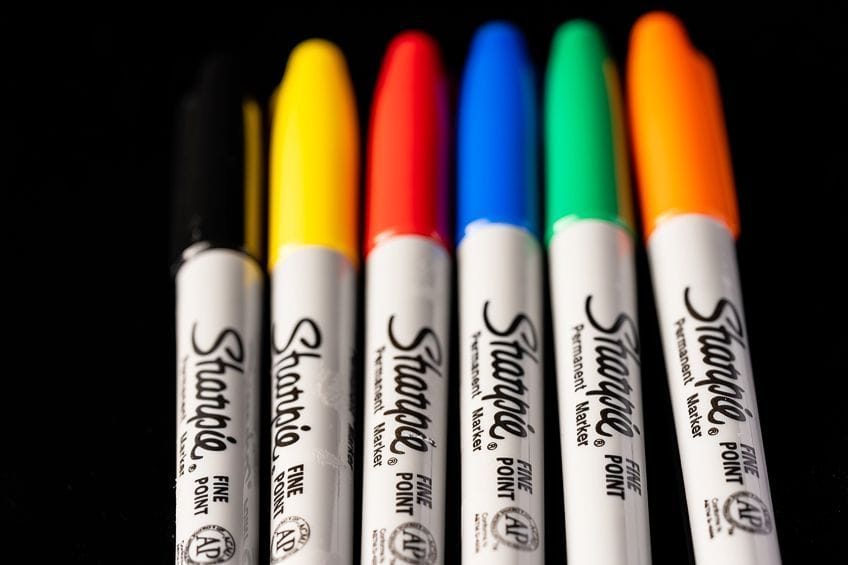
Best Value: SHARPIE Oil-Based Paint Markers
These medium bullet-tip paint markers are a great value option for people looking to try their hand at using paint pens on wood. They are vibrant, and opaque on both light and dark surfaces. They can draw on dusty and rough surfaces with ease and are resistant to water, abrasion, smearing, fading, and peeling. These Sharpie markers have a gloss finish once dried. This is a simple assortment of eight colors that can go a long way for people only just beginning to experiment. If you do not want to buy a large or expensive pack of paint markers just yet then these sharpie markers are a great value purchase. They are high quality and reliable without breaking the bank.
- Highly pigmented colors resist fading, water, and smearing
- Suitable for a range of surfaces, including wood and stone
- Medium tip creates highly visible and glossy lines
They are quick-drying and non-toxic which makes them great for kids too. They work on many other surfaces aside from wood so they do not have to be packed away after one or two uses if you run out of wood to draw on. They work on ceramic, fabric, rocks, glass, plastic, and more. The markers have a valve that controls the rate of flow of the paint. This ensures that the flow remains constant and even, without you having to worry about dripping. The markers are also leak-proof so you don’t have the concern of them leaking in your bag or drawers if you have properly sealed the cap on.
PROS
- Opaque and vibrant colors
- Glossy finish
- Versatile tip shape and size
- Valve creates an even flow rate
- Can be used on rough surfaces
- Quick-drying and permanent
- Resists water, abrasion, fading, and peeling
- Non-toxic formula
CONS
- Color choice is limited
- May have a strong scent
- May dry up or clump if stored incorrectly
- Colors cannot mix
Budget-Friendly Choice: ARTISTRO Paint Pens
This affordable pack of paint markers has twelve different colors, including gold and silver metallic paint markers. They are water-based but still very vibrant. These Artistro markers have a glossy finish and a smooth flow rate. They will require shaking before and during use and may be prone to leaking if not stored correctly.
- Highly pigmented acrylic ink dries quickly and is very durable
- Medium tips are perfect for fine details and filling large areas
- The set of pens includes 12 bright and vibrant colors
The Artistro paint pens are medium tipped which makes them great for use on wood. They are water-resistant, fade-proof, and durable as well as non-toxic, and odor-free. You can see into the markers which helps you know how much paint you have left. This helps to make sure that you can keep an eye on the level of paint in your marker and never run out of in the middle of a piece
PROS
- Vivid colors
- Large range of colors including two metallic markers
- Affordable
- Can be used on many surfaces
- Non-toxic and odor-free
- Water-resistant
- Can see inside the marker
- Can mix colors if fast enough
CONS
- Finer tips that may not be suitable for larger projects
- Water-based markers may not be as resistant to damage
- Will need to be shaken regularly during use to ensure a constant flow
- May leak if stored incorrectly
Premium Choice: UNI-POSCA Paint Marker Pens
These Uni-Posca paint marker pens are perfect for all surfaces but especially wood. They have a non-toxic formula and dry very quickly, which makes them perfect for use by children too. They are durable and waterproof and distribute ink smoothly and evenly across surfaces.
- Water-based ink is non-toxic, lightfast, and waterproof
- Includes 15 vibrant and highly pigmented colors
- The pigmented ink does not bleed or run
The pack of fifteen markers includes colors that are all vibrant and dry to a matte finish. They are packaged simply and compactly by a reputable long-standing brand. These Uni-Posca markers are not prone to leaking, running, pooling, or dripping. The felt tips of these markers may however be at risk of wearing down from abrasion on rough surfaces.
PROS
- Good range of colors
- Permanent, water-proof, and smudge resistant
- Can mix colors if fast enough
- Bright, vibrant colors with a matte finish
- Reputable brand
- Can be used on various surfaces
- Even and smooth application
- Non-toxic; suitable for children
CONS
- Requires intermittent shaking during use
- A bit pricey
- Felt tips may wear down over time on rougher surfaces
- Water-based markers may be less durable
Tips and Tricks for Using Paint Markers Correctly
If you are wondering about the best paint pens for wood then you may also want to know some important tips and tricks for using them correctly. Once you have chosen a brand of paint markers for wood then you can make sure that you have read through our advice below, before moving on to our tutorial. If you have a paint pen to write on wood you will find that they are more high-maintenance than traditional markers. These tips will help make sure that you apply your paint without the hassle and that you store them correctly so that they will last you a long time.
Remember to always read the manufacturer’s instructions as they will give you product-specific insights regarding the care and use of your paint markers.
- Always shake your pen before use. This is to make sure that the paint is properly dispersed throughout the marker before you start. If the paint was not properly dispersed you could have the paint coming out, and then stopping suddenly before continuing again later in a stroke. This could cause issues in your work and have you waste time going back to touch-up gaps in your drawing. On your first use, you may have to shake the marker for at least a minute or two. Keep the lid on while you shake the marker or you could make a big mess. Failure to shake the pen properly before use could result in bubbles that will prevent smooth paint flow onto your surface.
- Remove the cap while holding the pen upright and press down the tip of the marker once with your finger. This will remove air from the paint pen and help to activate your paint marker for its first use. You will not need to do this again after using your pens for the first time.
- Make sure that if you are working with an extremely rough piece of wood that you have sanded it down to make it easier to draw on. It will also help you avoid getting any splinters while working. Working on a very rough surface can also wear down your markers or cause the paint to disperse oddly.
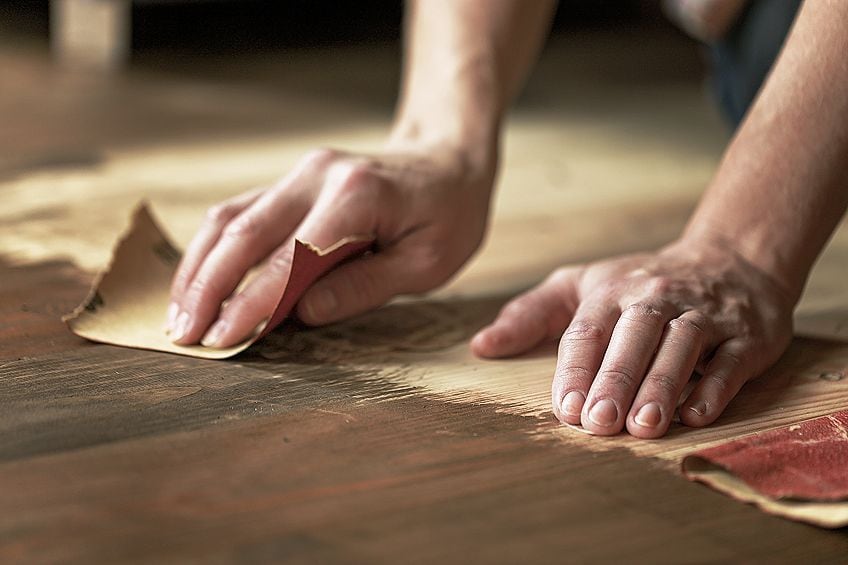
- Press the tip of the marker down on a paper towel or piece of paper. Allow the paint to run down the tip and into the napkin. Repeat this a few times on different areas of the paper. This is to allow the paint to flow to the tip and fully prime the marker for use. Repeating this step helps to ensure that the paint will not drip too much onto your surface. Too much dripping could cause blobs or smudges on your wood. You should prime your marker in this way before every use, regardless of whether it is a water-based or oil-based marker.
- When you begin using your marker do not press down too hard. Too much pressure can leave a pool of paint on the wood or damage your tip. Glide the marker across the surface until you have drawn your line or until the paint stops running.
- If the paint stops running you will just dab it on the paper towel to prime it once again.
- You may also need to shake the pen while using it. Make sure that you have replaced the lid on your marker before you shake it.
- When you are done using your marker you can replace the cap and store them somewhere at room temperature. If there is excess paint on your tip, wipe it off before replacing the cap.
- Some markers are better stored horizontally and others store better vertically. Make sure that you read the manufacturer’s instructions with regards to the proper storage of your markers.
- If you forget to replace the cap on your markers and a tip has dried out, you can pour some isopropyl alcohol into a container and dip the tip in. This process helps to reactivate the ink. Try your best to not leave your markers exposed as this method isn’t fool-proof, but it can work in a pinch.
How to Write on Wood Using Paint Pens: A Step-by-Step Tutorial
Once you have chosen the best paint pens for drawing on wood you can refer to the in-depth guide below that will guide you through the process of creating your piece. We include a few extra ways to try to ensure you get the best possible outcome but these methods are not necessary with good quality paint markers for wood.
The following supplies will make your life easier when using paint pens on wood surfaces:
- Paint pens for wood
- Old newspapers or a tarp
- A wooden surface
- A lightly dampened cloth
- Paper towels
- 140-180 grit sandpaper
- Primer
- Graphite pencil
- Sealant spray
Set up your working area in a brightly lit, well-ventilated room by putting down old newspapers or a tarp. Keep a dampened cloth nearby as well as paper towels in case of any accidental messes. Prepare the wood (optional). If you have a very rough piece of wood, it may be a good idea to sand the wood down using 140 to 180 grit sandpaper. Once the wood is sanded smooth you can wipe it down with a damp cloth and allow it to dry. Apply a thin coat of primer to the wood (optional). Allow the primer to properly dry before continuing. This will help the paint adhere better to the wood although it is not necessary. Use a graphite pencil to lightly sketch the outline of your drawing or pattern (optional). This can help you feel more confident once you begin drawing with the paint marker as you will not be as worried about making a mistake and having to clean it up.

Shake and prime the marker. Shake the pen for at least a minute or according to the manufacturer’s recommendations, while the cap is still on. Remove the cap, hold the pen upright, and press lightly on the tip with your finger for a few seconds. Turn the marker tip-down and press the tip down on paper towels or old newspaper until the paint begins to run. Start drawing. Stop to replace the cap then shake and prime the maker more if the flow of your pen slows. If you make any mistakes, you can wipe them up with a damp cloth while they are still wet. If the paint has dried you can use a mild detergent to aid this process or attempt to chip off the paint with a craft knife. Refer to our FAQs for more information regarding this.
Make sure the tip of your marker is clean and store it correctly. Follow the manufacturer’s instructions regarding the cleaning and storage of your markers. Some pens prefer being stored vertically while others must be stored horizontally. Be sure to fit the cap properly on your markers before storing.
Seal your finished piece (optional). Use a sealant of your choice to seal your work permanently and protect it from damage over time.
Ideas for Projects Using Paint Markers on Wood
Paint markers are great for many projects. Once you get started using paint pens on wood you are going to start wondering about all the great projects you can do. We have a few ideas that can help to get you started. For example, if you can get your hands on some log sections you could paint landscapes or inspirational messages on them. These sections can be hung on a wall or used as coasters or placemats. Wood sections are beautiful and easy to come by, which makes them perfect for crafters. Another idea is to add patterns to the handles of your wooden kitchen utensils. This can add some fun to your living space and routines, or make for a great gift. Abstract, geometric or floral patterns are all great ideas!

You could also spruce up the drawers of a dresser or side table with some patterns or drawings. This is especially fun for children’s rooms; you could draw a scene full of all their favorite characters. Drawing on doors or picture frames is yet another great idea that can breathe some life into your home. Painting a wooden picture frame with markers is a great gift idea to give to family or friends. Paint around the frame and add a picture taken of you and your loved one, wrap it up, give it to them and see how much they will adore it!
Once you begin working with paint markers on wood you will start to see opportunities everywhere you look. Your imagination is the only limit and wood is a lovely, abundant, natural medium to use in your pieces. Paint markers are a great way to draw on wood and having a quality set on hand opens up endless craft projects.
Frequently Asked Questions
Can You Use Sharpies on Wood?
Yes and no, Sharpie makes a range of paint pens that specifically work on wood, but it is not the best idea to just use any sharpie you have lying around for your piece. You may not get the result you are hoping for as not all sharpies are suitable for use on wood. If you have a sharpie you want to use it would be best to find out on the internet if it will work effectively on wood.
How Do I Prevent Paint from Bleeding on Wood?
If you use the right paint pen then it should not bleed on your wood. If you have chosen a quality pen and there is bleeding, try to adjust your technique according to our advice above. If you still have issues with paint bleeding out into your work then you may need to consider what kind of wood you are using. Some woods are more porous than others and may be more prone to paint bleeding. Try changing the kind of wood you are using if the issue persists.
How to Get Paint Marker Off of Wood?
To remove wet marker paint off of wood, you can use a Kleenex or dampened cloth and simply wipe it away. You can also use mild detergents to assist in the removal of paint. Once the area is clean, allow the wood to properly dry. To remove dry marker paint off of wood, use a cloth dampened with rubbing alcohol to dab the paint away. Rinse the area with water once cleared of paint and then dry using a clean cloth. If the mark persists you could seek out specialized cleaning agents.
Are Paint Markers Safe for Children?
Some brands are safe for children but always read the product description. Most brands on the market are non-toxic but you should never assume this is the case. Caps for the pens will always be a choking hazard for smaller, unsupervised children while the paint can also stain clothing. We suggest not leaving children unsupervised even with non-toxic paint marker brands.
In 2005, Charlene completed her wellness degrees in therapeutic aromatherapy and reflexology at the International School of Reflexology and Meridian Therapy. She worked for a company offering corporate wellness programs for several years before opening her own therapy practice. In 2015, she was asked by a digital marketer friend to join her company as a content creator, and it was here that she discovered her enthusiasm for writing. Since entering the world of content creation, she has gained a lot of experience over the years writing about various topics such as beauty, health, wellness, travel, crafting, and much more. Due to various circumstances, she had to give up her therapy practice and now works as a freelance writer. Since she is a very creative person and as a balance to writing likes to be active in various areas of art and crafts, the activity at acrylgiessen.com is perfect for her to contribute their knowledge and experience in various creative topics.
Learn more about Charlene Lewis and about us.






